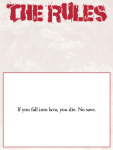Hiya.
I think you're still thinking "backwards". The rules do not dictate how the game will progress; that is entirely up to the DM and players. The rules may shape the outcome of that progression, however.
Do you think tossing someone off a 400' cliff to jagged rocks below should be "insta-death"? Ok, they use the rules as is and roll 20d6 damage. That doesn't fit with your idea of "heroics"? Ok, give the PC a save for half damage. Still not good enough? Let them make a Dex save to try and avoid being thrown off in the first place. You see, you take the premise of what direction you want the game to progress, then you use the rules to shape that progression. You generally don't want "automatics"; far to predicable and boring...you want some chance of failure so that the chance of success is sweeter when it happens.
I agree with the third paragraph ("Because, the rules cannot help but shape the narrative and the world..."), overall. And, IMHO, the rules do exactly that; make the DM's life easier. It gives the DM a baseline from which to make consistent rulings. However, *all* DM's are game designers...they have to be. It's part and parcel of "The Job". A DM's job is to basically "create on the spot" rules and whatnot simply because no rules system can cover every situation. This is why, IMHO, "simplistic rules" are much better than "specific rules" when it comes to RPG's.
"Designing" a cool climactic storyline ending encounter should focus on what the DM thinks would be cool first...not looking at rules and then designing the encounter (that's the backwards thinking I was talking about). If the DM wants a big, climactic battle at the pinnacle of an icy peak, he should start thinking of what he envisions as being "fun" and "cool", then look up rules that may need to come into play. If he finds rules lacking (either nothing is there to fit it, or they don't help with making it "cool"), then it is the DM's job to come up with something to make it fun and cool. Its not "wrong" for a DM to make up new rules to handle or otherwise encourage some sort of exciting situation. If a DM does nothing to make the encounter fun and exciting, and only uses the boring base-line rules in the book...well, that's a sign of a poor DM, IMHO.
^_^
Paul L. Ming

